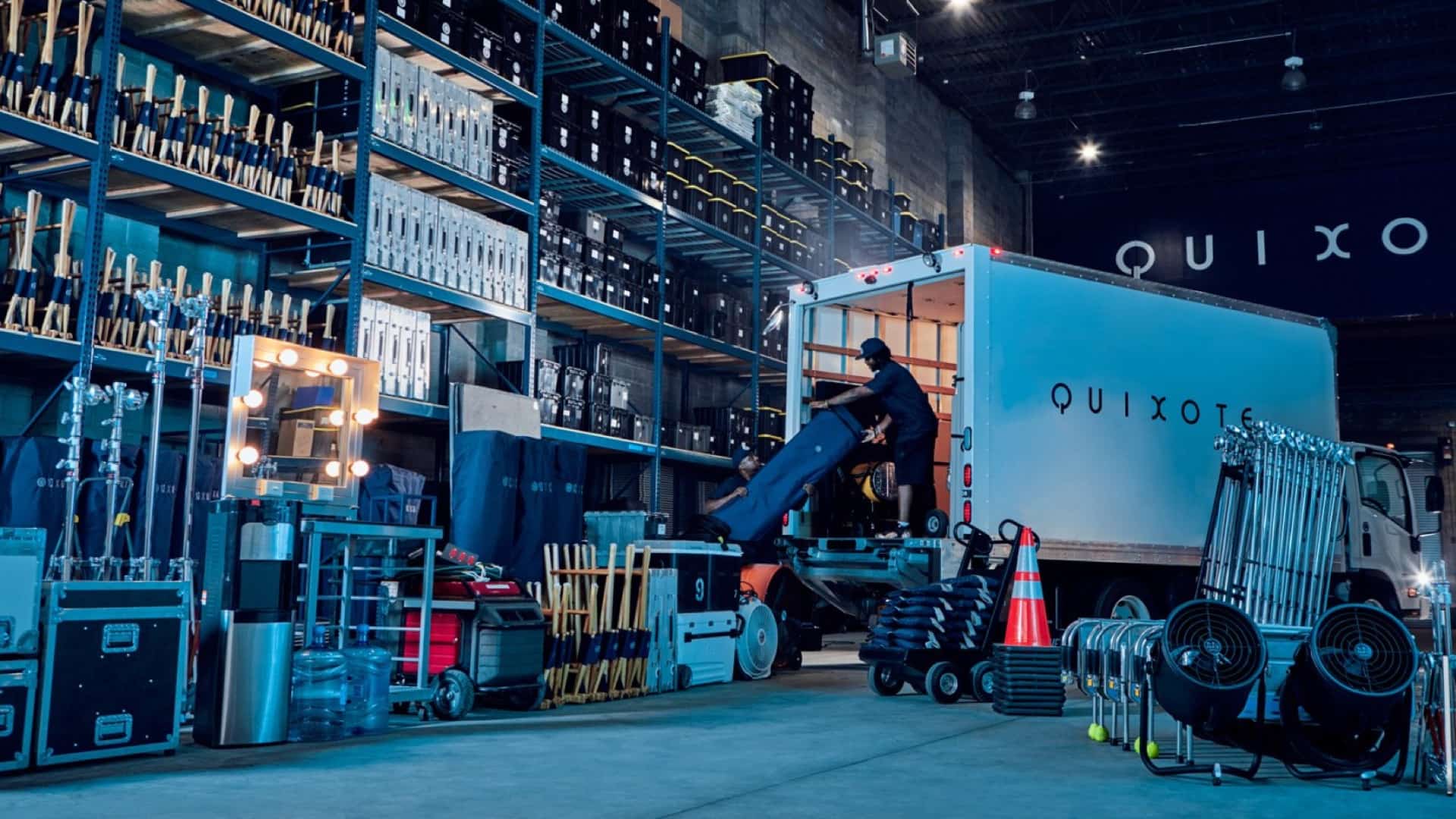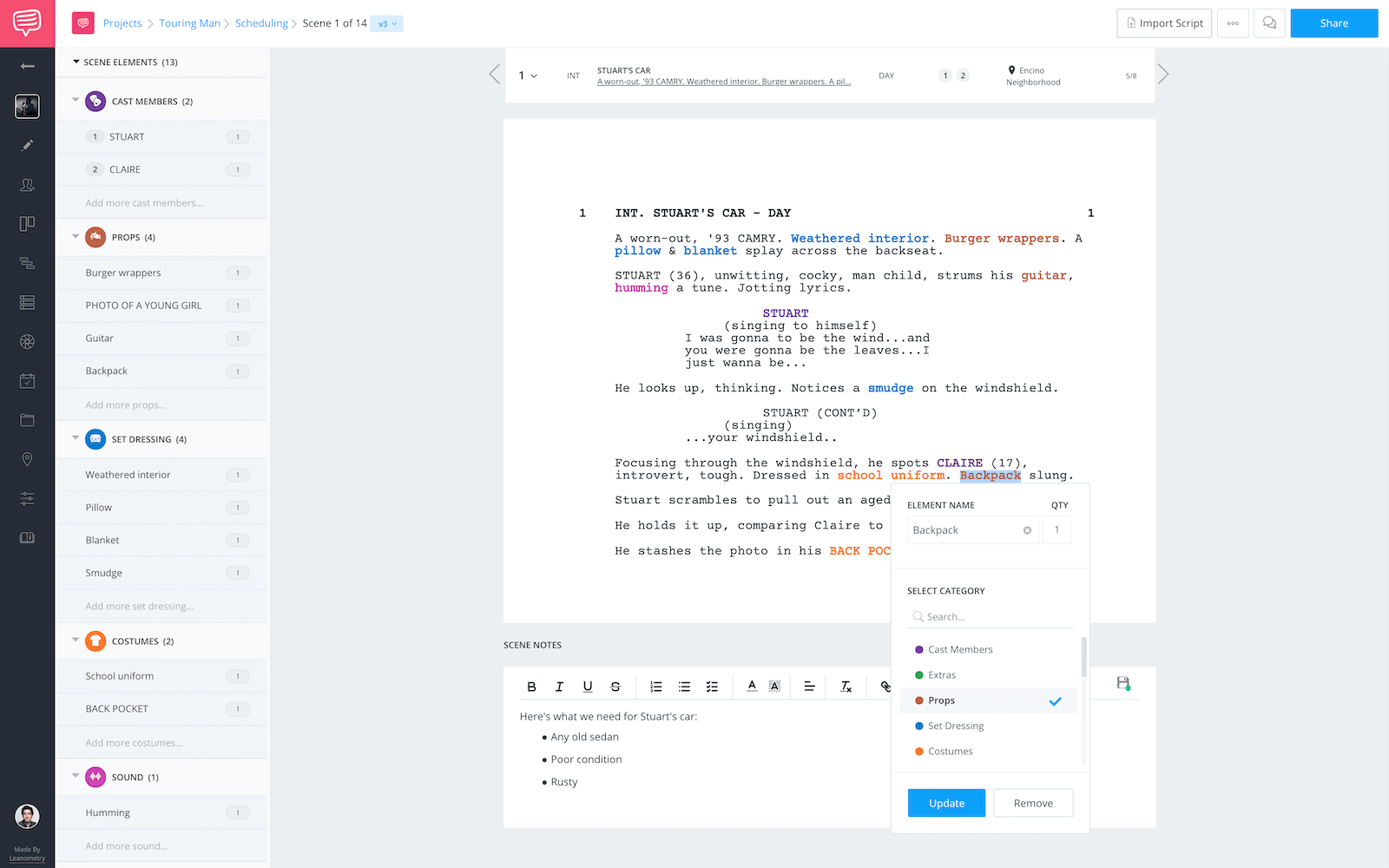Video equipment rental is essential for most productions, but navigating what your crew wants and what your budget can afford can be an overwhelming process, even for seasoned producers.
In this post, we will lead you through the rental process, and show you the best places for video equipment rental. Then we’ll discuss creating your gear list, using your department heads, testing the gear, production insurance, and how to return your gear in great condition.
1. SCRIPT BREAKDOWN
Breakdown your script
The first step in renting equipment is sharing the script breakdown with your Department Heads. You do this to figure out exactly what equipment you and your team think they need.
Here's a video breakdown of the various types of camera rigs, how they work, and how they add to the "feel" and look of a shot.
Ultimate Guide to Camera Gear • Subscribe on YouTube
The best way to figure out exactly what each department needs is with a script breakdown. A script breakdown helps identify every component in your scene, including props, sets, costumes, etc.
Also, any special equipment or special effects will be in the breakdown.
Breakdown your script
Once you have your breakdown, you can generate a shot list, a shooting schedule, a storyboard, and a budget.
You can see why the script breakdown is so important.
Here is what a finished breakdown looks like:
These elements from the breakdown should be shared with your department heads.
Though on period-specific productions, there are exceptions.
Sometimes wardrobe, hair-and-makeup, and props become their own departments on larger shoots.
This is also true for other departments like locations and transportation as well.
There are no absolutes in film production.
Find the best way to work with each project as it comes. Though a standardized approach to pre-production is recommended a guide like this one will help you stay on track when unforeseen curveballs are thrown your way.
Now that the script is broken down, we can get into the in's and out's of video equipment rental.
RELATED POSTS
2. CREATE EQUIPMENT LIST
Create a gear list and get insurance
The next step in will be creating equipment lists, and then securing insurance that will cover the value of the gear you hope to rent.
Some rental services will allow you to organize insurance through their service. Generally, you want to get annual insurance so you can cover multiple productions for better rates.
You also want to get as low a deductible as possible, but just like with any other type of insurance, this will raise the cost.
Guide to Production Insurance
Your department heads will take the shot list, storyboards, and schedules and review them. Then, in one big pre-production meeting, everyone will discuss what they need for their department to realize the scenes as scripted.
This is done scene-by-scene for every scene. Depending on the script, this meeting can be a pleasant afternoon or a week-long discussion.
After the meeting, the department heads will be on the same page. At some point, you will let your departments generate their equipment lists.
The DP will make a wishlist for the camera department, such as the camera, lenses, tripods, mounts, and maybe even film stock.
Buying Gear vs. Renting Gear
The Art Department will have one of the biggest lists on most shoots and can include everything from wood for set construction to props, costumes, fog machines, picture cars and much more.
You could be dealing with many different rental companies for the art department, but the art department should ideally have a coordinator who should be there to help.
After the department heads give you their list, you or your production manager will determine what equipment will be needed to support the entire operation.
If you've found a seasoned DP, they may be able to help you figure out the camera rentals by negotiating the packages themselves, as they are often familiar with the rental houses or private renters.
Try your best to stick with one company for as much as possible as you will be able to get better discounts on the entire rental list.
3. RENT FILM GEAR
Find the best places to rent film gear
Now it is time to find the best film gear rental houses so you can secure some equipment for your production.
Bear in mind, you will need to get production insurance that will cover the total value of the gear you plan to rent — and don't forget about adding your deductible into your budget!
There are dozens and dozens of places around LA for video equipment rental but here is a list of our favorite rental houses:
ShareGrid
ShareGrid allows you to rent gear from private renters and rental houses all in one place. You can secure production insurance at a yearly rate, or cover an individual production.
Live bids come in from rental houses and you can even buy and sell. They have everything from video, audio, G&E, light packages, and more.
ShareGrid Rentals
Almost every one of the other rental houses on this list can be found on ShareGrid, so it really is a great one stop shop for your video equipment rental needs.
The other great thing is that you don't have to be in LA to rent. We've used ShareGrid a bunch of times and it has been a great experience.
Line 204
Not everything you need to rent will be a camera or a lens, but sometimes you just need a cube that can carry other film equipment like dollies, track, tables, chairs, ratchet straps, coolers, whatever.
Line 204 Rentals
Line 204 is a good option because they provide all of this for a reasonable price, they keep your equipment safe in a security guarded and gated parking lot in case you need to park it overnight, and they provide ladders, tables, etc.
Quixote
Quixote is one of the best known production equipment rentals in New York and Los Angeles, and they are a great option if you can swing it.
Quixote Rentals
They aren't ridiculously priced, but they are a professional resource that offers studio space, trucks, and film gear.
Wooden Nickel
Lighting is just as important as anything else. When it comes to G&E, there are few rental houses other than Wooden Nickel that are both as accessible and well known.
They will rent out lighting gear, stingers, light stands, c-stands, flags, apple boxes, and anything else you might need.
The Camera Division
The Camera Division has been used for a huge number of professional productions, and you can see their credits on their website.
They also provide productions with lighting equipment, so you can get both out of the way and possible get a nice little bundle price.
KitSplit
KitSplit works a lot like ShareGrid, and you will find their services very similar. You can get your production insurance and rent gear from rental houses, private renters, and also find some additional resources.
FatLlama
FatLlama is another gear sharing platform that give your reasonable prices, and covers more than just video equipment rental.
You can also rent DJ equipment, bicycles, all sorts of stuff. It definitely loses some of the focus, but for an indie filmmaker it is a good option.
Parachut
Parachut takes a subscription model and applied it to film gear.
You choose your level of subscription, pay the fee, gain a certain amount of points, and then spend that monthly allowance on gear.
You get to keep the gear for as long as you like, or at least, as long as you keep your subscription. You can send in gear to refill your points, and get a new piece of gear, all with free shipping.
LensRentals
LensRentals is a big resource and it will allow you not only to rent the lenses you'd like to try, but also apply your rental fee toward a purchase.
They are pretty limited as far as an entire film production situation goes, but if you need some optics or camera gear, they are a good option.
BorrowLenses
BorrowLenses and LensRentals are very similar, and they are good to comparison shop against for a particular lens.
These are great options when you already have most of your gear, but need a little bit more to take your visuals up to the next level.
RELATED POSTS
4. TEST FILM EQUIPMENT
Test your film equipment first
Our next simple step is prepping and picking up equipment.
This will be a different process for every department, but each department should be well acquainted with their responsibilities.
They need to check the equipment because if something doesn't work on set, not only are you somewhat out of luck for your production, but you may be blamed by the rental house for the faulty equipment.
Now, one of the advantages of using a professional rental house is that they will test the gear right there in front of your camera team.
One of the most important preps for the film shoot is with the camera department. Depending on the type of camera, the 1st Assistant Camera will inspect and prepare the equipment for use and transport.
The Key Grip and Gaffer will inspect their truck. The Special Effects Assistant will try the rain machine and so on.
Someone from every department will make sure that the equipment is ready to be used. If there needs to be replacements, changes or additions, you will be notified very quickly, so be ready.
This is one of the reason it is important to keep your production and crew list as organized as possible, and when you use a production planning software, you can see each task checked off in real time.
StudioBinder Production Software
Every department will be given invoices and receipts for the deposits and rentals.
Every invoice or receipt will be given to production. If you are not emailed an invoice or receipt from the rental house contact, it is not out of the ordinary to have your crew member take a picture.
This is especially useful if they will not be joining production immediately after prep and pick up. This is also a way to prevent any surprises. No surprises are the only good surprises in production.
5. Return equipment
Return equipment like a pro
Renting film gear is only half of your job, because the other half is keeping it in good condition so you can return it without any issues.
You also need to return it on time to avoid costly overages.
Remember, returning your equipment even an hour late can get you a full day’s charge at non-negotiated rates. Avoid this mistake at all cost.
When you receive the final invoice it will reflect any additional expenses, discounts, and loss and damage charges if anything is broken, lost or stolen during your shoot.
If you have a rather large deductible, and something went wrong on set, this may end up costing your production thousands of dollars.
How to rent and load a grip truck
This is another reason why you only allow professionals to touch expensive gear, why each department should be the ONLY people touching their respective gear, and why you need to consider good production insurance.
$500 for a year of production insurance will protect you and keep your deductible low, and you'll be able to avoid paying $3000 to a rental house because a camera monitor fell over on set.
UP NEXT
The essential duties of a line producer
Renting equipment is a piece of cake with these seven simple steps. Now that you got the process down, perhaps it’s time to step up your game and learn everything you need to know about being a line producer.
Up Next: Duties of A Line Producer →
Manage talent & film crew contacts, all in one place.
Create and share mobile-friendly contact lists, call sheets, calendars and more. Complete video project management for producers & coordinators.

